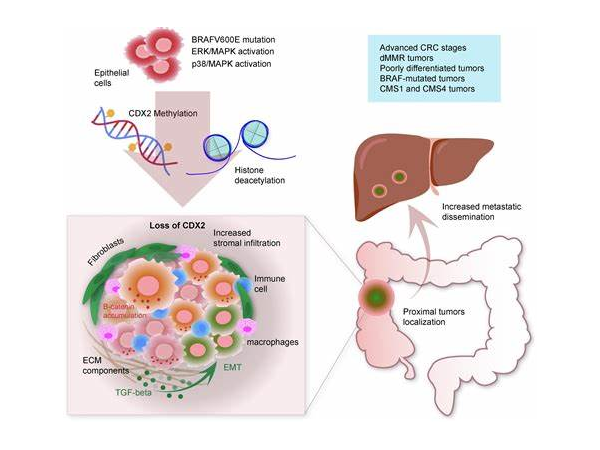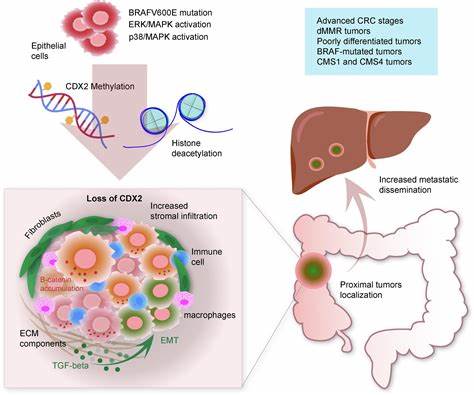CDX2: An Underestimated Key Factor in the Diagnosis and Treatment of Colorectal Cancer

Characteristics of CDX2
CDX2 belongs to the caudal type homeobox gene family and is specifically expressed in intestinal epithelial cells. Its gene has a total length between 22 and 23 kilobases (kb), is located on chromosome 13, and is exquisitely composed of 3 exons and 2 introns. The CDX2 protein encoded by it contains 311 amino acids. With its unique helix-loop-helix structure, it can precisely bind to the corresponding region of DNA and regulate gene expression in the capacity of a transcription factor, which is of great significance for maintaining the normal morphology and function of intestinal epithelial cells. At the cellular level, it is like an accurate "commander" that controls the balance of the proliferation and differentiation of intestinal epithelial cells, ensuring the orderly operation of the intestinal tissue.
The Role of CDX2 in the Onset and Progression of Colorectal Cancer
A large amount of research evidence shows that CDX2 exhibits the characteristics of a tumor suppressor gene during the process of colorectal cancer. In the mouse experimental model, the homozygous deletion of CDX2 will lead to the death of growing mice, while the heterozygous deletion is likely to cause the formation of hamartomatous polyps and tubular adenomas, providing preliminary animal experimental evidence for its role in tumor suppression.
At the molecular mechanism level, there is a complex interaction between the active Wnt signaling pathway in colorectal cancer and CDX2. When the Wnt signaling pathway is activated and accompanied by high expression of SOX9, the expression of CDX2 significantly decreases or even disappears. CDX2 can combine with CDX1 to effectively inhibit the proliferation of colon cancer cells by blocking the transcriptional activation of β-catenin/TCF downstream of the Wnt pathway.
In addition, CDX2 can also inhibit the phosphorylation of Akt and GSK-3β, reduce the expression of Snail, the stabilization and nuclear translocation of β-catenin, and directly bind to the PTEN promoter and trans-activate its expression, antagonizing the activity of PI3K/Akt in colorectal cancer from multiple dimensions and comprehensively inhibiting the occurrence and development of tumors.

CDX2 as a Prognostic Indicator
1. The Key Significance of CDX2 in Stage Ⅱ Colorectal Cancer
Patients with stage Ⅱ colorectal cancer are in a delicate stage. The cancer focus invades the colon wall and may even invade surrounding tissues and organs, but it has not yet involved the lymph nodes. Most patients can have the cancer focus completely removed through surgery. However, 15% - 20% of the patients are still at risk of tumor recurrence and death due to metastatic tumors. Traditionally, the judgment of high-risk factors for stage Ⅱ colorectal cancer mostly relies on non-biological indicators, such as undifferentiated or poorly differentiated postoperative pathology, tumor vascular invasion or nerve invasion, preoperative intestinal obstruction, less than 12 lymph nodes in the intraoperative pathological biopsy, and local intestinal perforation.
However, an important study published in the New England Journal of Medicine has changed this situation. The research team deeply mined the data of more than 2000 colon cancer patients and found that 16 genes with lack of expression were related to high-level cancer stem cells, among which the CDX2 gene stood out. Among colon cancer patients, the proportion of CDX2 expression deficiency was 4.1% (87/2115). Further evaluation of the survival rate of 466 patients showed that the risk of colon cancer recurrence and death in CDX2-negative patients was much higher than that in positive patients.
The immunohistochemical data intuitively showed that the 5-year overall survival (OS) rate of CDX2-negative expression was only 6.9%, while that of positive expression was as high as 93.1%. Subsequent analysis of a total of 669 stage Ⅱ rectal cancer patients and 1228 stage Ⅲ rectal cancer patients from multiple cohorts showed that the 5-year OS rate of stage Ⅱ colorectal cancer patients with negative CDX2 expression was between 49% - 51%, and that of positive patients was between 80% - 87%.
More importantly, for CDX2-negative patients, postoperative chemotherapy significantly improved the disease-free survival (DFS) (stage Ⅱ: 91% vs. 56%; stage Ⅲ: 74% vs. 34%), fully demonstrating the important value of CDX2 in the prognosis judgment and treatment decision-making of stage Ⅱ colorectal cancer.
2. The Prognostic Indication of CDX2 in Advanced Colorectal Cancer
A retrospective study included 78 patients with stage III/IV colorectal cancer. Among them, the proportion of CDX2-positive patients was 74.4% (58/78), and the proportion of CDX2-negative patients was 19.2% (15/78). The survival outcome analysis clearly showed that the OS of CDX2-negative patients was significantly shorter than that of positive patients, which were 27.8 months and 36.4 months respectively.
Among 34 patients with metastatic CRC, the median overall survival (mOS) of CDX2-negative patients was only 4 months, while that of positive patients could reach 13.8 months, highlighting that the prognosis of metastatic CRC with CDX2 negativity was worse. Kristine Aasebø and others conducted a retrospective study on 452 cases of unresectable CRC and found that the CDX2 expression deletion rate was 19% (87/452).
Subgroup analysis revealed that CDX2 deletion was closely related to BRAF mutation, microsatellite instability, and poor differentiation, and was negatively correlated with KRAS mutation. The median progression-free survival (PFS) and OS of CDX2-deleted patients receiving first-line chemotherapy were 4 months and 10 months respectively, which were much lower than the 9 months and 24 months of CDX2-expressing patients.
At the same time, the proportion of CDX2-deleted patients with immediate progression in first-line combination chemotherapy was as high as 35%, while that of expressing patients was only 10%. Multivariate analysis confirmed that CDX2 deletion and BRAFmut were independent markers of poor OS prognosis.
Prospects for the Clinical Application of CDX2
In view of the key role of CDX2 in the mechanism of the onset and development of colorectal cancer and its significant value in the prognosis judgment of colorectal cancer at different stages, it is urgent and necessary to include it in the scope of routine pathological detection.
Especially in the diagnosis and treatment of stage Ⅱ colorectal cancer, CDX2 may become an important biological indicator for determining whether patients need postoperative adjuvant chemotherapy, helping doctors to formulate more personalized treatment plans more accurately, avoiding overtreatment or undertreatment, bringing more survival hope to colorectal cancer patients, and promoting the improvement of the diagnosis and treatment level of colorectal cancer to a new height.
Product Information
| Gatalog Num | Product Name | Product Parameters | Price |
| S0B2079 | CDX2 Recombinant Rabbit mAb (SDT-134-76) | Host : Rabbit | $880 |
Reference
1. Tomasello G, Barni S, Turati L, Ghidini M, Pezzica E, Passalacqua R, et al. . Association of CDX2 expression with survival in early colorectal cancer: a systematic review and meta-analysis. Clin Colorectal Cancer. (2018) 17:97–103.
2. Zhang BY, Jones JC, Briggler AM, Hubbard JM, Kipp BR, Sargent DJ, et al. . Lack of caudal-type homeobox transcription factor 2 expression as a prognostic biomarker in metastatic colorectal cancer. Clin Colorectal Cancer. (2017) 16:124–8.
3. Bae JM, Lee TH, Cho NY, Kim TY, Kang GH. Loss of CDX2 expression is associated with poor prognosis in colorectal cancer patients. World J Gastroenterol. (2015) 21:1457–67.
4. Dalerba P, Sahoo D, Paik S, Guo X, Yothers G, Song N, et al. . CDX2 as a prognostic biomarker in stage II and stage III colon cancer. N Engl J Med. (2016) 374:211–22




